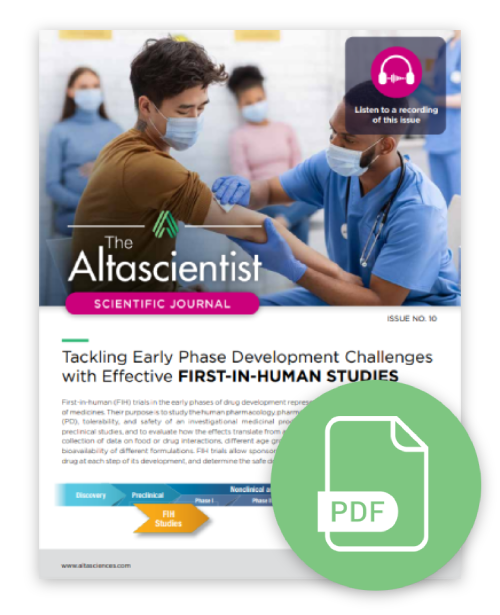ISSUE NO. 10 — Tackling Early-Phase Development Challenges with Effective First-in-Human Studies
First-in-Human (FIH) trials in the early phases of drug development represent a critical milestone in the approval of medicines. Their purpose is to study the human pharmacology, pharmacokinetics (PK) and pharmacodynamics (PD), tolerability, and safety of an investigational medicinal product (IMP) having already gone through preclinical studies, and to evaluate how the effects translate from animals to humans.
They may also include the collection of data on food or drug interactions, different age groups or gender, proof of concept, and relative bioavailability of different formulations.
In Issue 10 of The Altascientist, we review:
- Designing a FIH trial
- Key aspects of FIH trial designs
- Access to patient populations
- Integrating adaptive designs into FIH trials
- A single-center, randomized, placebo-controlled, double-blind, adaptive, FIH study case study
Designing a First-in-Human Clinical Trial
Unexpected toxicity is the primary reason a drug’s development is halted or terminated. To maximize the probability that a drug will make it from Phase I to market, sponsors need to ensure the preclinical study results obtained are complete and of the highest quality, and that their clinical study design contains all the vital elements to ensure a successful outcome.
When selecting a CRO partner, it is paramount to seek one that can ensure participant safety while prioritizing science and the collection of accurate clinical data. They need the required expertise, a strong project management team, and the operational and technological capabilities to implement adaptive trial designs whenever possible.
Partnering with a CRO such as Altasciences, that has in-depth experience with both preclinical and clinical operations, allows you to work with a single, integrated CRO that can carry your early-phase trials from lead candidate selection to preclinical testing to clinical proof of concept—seamlessly across disciplines, and in the most time- and cost-efficient way possible.
Integrating Adaptive Designs in First-in-Human Clinical Trials
Traditional study designs, particularly in the later stages of drug development, are often criticized for being too rigid, requiring large sample sizes (often thousands of patients), having study timelines that run for years, and costing drug developers millions of dollars until the success or failure rate of the study drug is established. Since 2006, the FDA and EMA have encouraged the development and implementation of adaptive designs to increase trial efficiencies.
Adaptive trial designs are extremely helpful in improving clinical trial efficiency by identifying the optimal dose earlier on, reducing the sample population size, shortening timelines, and getting drugs to market faster, especially in the case of certain therapeutic areas, such as oncology, where failure rates are high.
While conventional trials focus on rapid recruitment and study start up, adaptive trials favor slower patient enrollment as they allow for changes to be made to recruitment based on how the patients are responding to the study drug. By securing specific sub-groups of patients more likely to yield the desired results, and suffer less adverse effects, the overall timeline of the trial can be accelerated.
These flexible trial designs allow researchers to analyze data at interim timepoints throughout the trial, using the results to make adjustments as the study proceeds, to produce a more positive overall outcome.
Explore all issues of The Altascientist in our Resource Center. And don’t forget to subscribe to “The Altascientist: Audiobooks” on Spotify, Apple Podcasts, or wherever you get your audio content.
